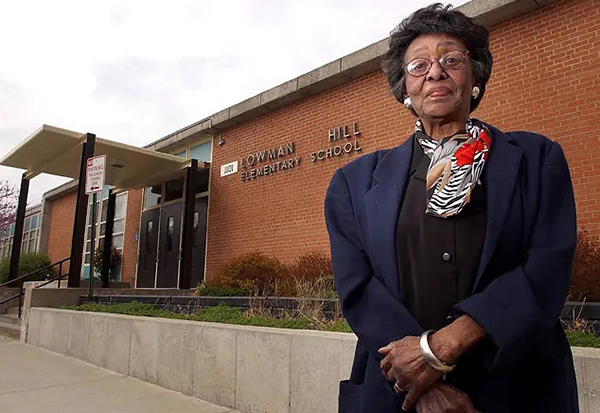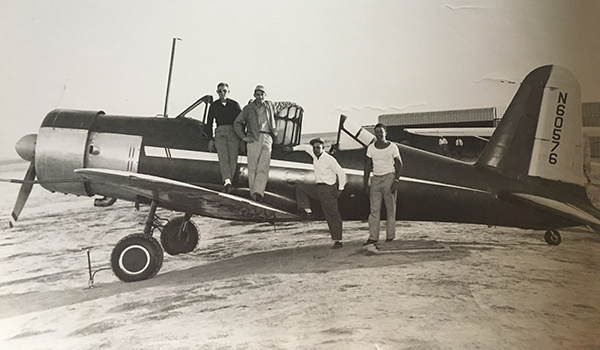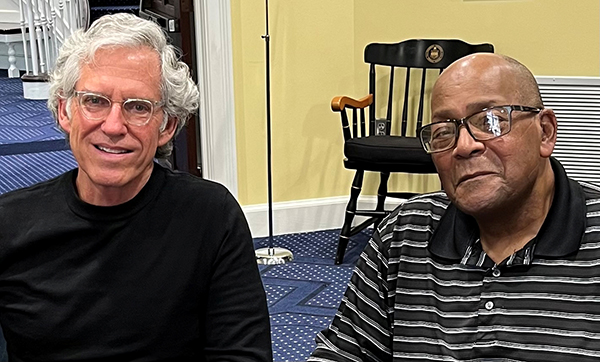Remembering Zelma
Bill Malloy establishes a scholarship to honor plaintiff in Brown v. Board of Education

Spring 2023
By Brad Porter
This Black History Month, Bill Malloy, ba '74, h '19, would like you to know the name Zelma Henderson.
Zelma (Hurst) Henderson was the last surviving plaintiff in the landmark Supreme Court case Brown v. Board of Education. Much of that history is well known – when the new Washburn University School of Law building opens, it will feature a mural display prominently heralding the alumni lawyers and judges involved in it, including the three African American Washburn Law graduates who filed the case. Less well known, perhaps, are the plaintiffs themselves, the 13 parents of African American public school students in Topeka whose class action led to dismantling school segregation nationwide. That list of plaintiffs begins with the name Oliver Brown, and the last “et al” was Zelma Henderson.
If you haven’t heard the name before, you’re not alone. Despite being relatively familiar with the history of the case, Malloy – who joined the Washburn University Foundation board of trustees this past spring – had never heard her name either. So he was surprised to discover a few years ago that this person, one of the plaintiffs in the biggest court case in U.S. history, was from the same small hometown he was.
Zelma Hurst was born in Colby, Kansas, and her family later moved to Oakley, Kansas – populations today of 5,500 and 2,000 respectively – before she married Andrew Henderson and moved to Topeka. Malloy himself was born in Oakley, and coincidentally his family later moved to Colby before he, too, wound up in Topeka – in his case coming to Topeka as a Washburn student.
In Topeka, Zelma Henderson studied cosmetology at the Kansas Vocational School and opened a beauty salon in her home. She had two children, Donald and Vicki, and by the time they reached school age, Zelma Henderson was angered to learn that they would have to be bused to a segregated all-Black school across town. Zelma had come from places small enough where segregation wasn’t possible. At that time in Kansas, schools were de facto integrated in towns such as Colby and Oakley – those with populations less than 15,000 – simply because there weren’t enough students to support separate schools. So when the NAACP came looking for parents to join a case challenging the Topeka Board of Education on its separate but equal policy, Zelma signed on and never looked back.
(While small towns may have lacked segregated schools, that isn’t to say they were necessarily warm to African Americans. Colby, for instance, had been a “sundown” town, where African Americans were allowed to visit or work in the community, but had to leave the city limits by sunset – Malloy can recall well into the 1950s the billboard looming over Highway 24 on the east side of town that ominously read “Don’t let the sun set on you.”)
The more Malloy learned about Zelma, the more he was impressed by her courage and determination. She was often described as fierce and tough and never backed down an inch when it came to her children or their right to fair schooling. And as Malloy kept digging, now thoroughly taken with the story of Zelma Henderson from his hometown, he came to discover that his own family connection to her ran deeper still.
Malloy’s parents moved to Oakley in the 40s, where his father, a former WWII bombardier, set up a crop dusting company and air ambulance service. Malloy remembered a photograph of the early years of what became Malloy Air Service. In it his father Jack, still a young man, is standing on an airplane he had just purchased for the business, with three other men. One was a White employee who worked with the company for years, but the other two, both Black men, Bill didn’t recognize.

He’d found the photo in his parent’s files after they had passed, so he pulled it out and took it to his older sister, who immediately recalled them. “Oh yes, Mr. Hurst, he worked for dad in Oakley.” After a little genealogical research, it became clear that the Hurst family in Oakley, including Zelma’s father, had at one point worked for Bill Malloy’s father in the early years of the business, helping to literally get it off the ground.
Malloy was moved by Zelma’s story, and by all the connections between Washburn and Brown v. Board, the Hursts and the Malloys. He has been a big fan of all the ways Topeka and Washburn have honored that history in recent decades, but while the civil rights movement was driven by big, prominent names – religious leaders, political figures, attorneys, activists—it was just as often regular folks like Zelma whose everyday courage moved mountains. Zelma Henderson was just a smalltown girl from Colby and Oakley, but her steadfast determination that her children ought to have the same educational opportunity as anybody else literally changed America. Or, as Bill puts it “No plaintiffs, no case. No case, no change.”
So recently, Malloy decided to create a Zelma Hurst Henderson fund, managed by the Washburn University Office of Diversity and Inclusion, and an endowed Zelma Henderson Scholarship to go with it. The Zelma Henderson Scholarship will offer young men and women the same educational opportunity Zelma had worked so hard to secure for her children – and, ultimately, for all children. A fitting tribute, Malloy hoped.

(Bill Malloy, ba '74, h ’19, meeting with Donald Henderson, Zelma Henderson’s son, at Washburn in 2022)
As a coda, Malloy recently had the opportunity to meet and visit with Donald Henderson, Zelma’s surviving son. Zelma passed away in 2008, but Donald was happy to reminisce about her, what she was like, those years in Topeka schools post-integration. Finally, Bill produced the photo he had found in his father’s belongings. Donald’s eyes lit up. He recognized it immediately. A copy of that exact photo had hung in his grandparents’ house until it was lost in a fire years ago.
Though Bill Malloy and Donald Henderson had never met before – had not even been aware of each other’s existence – that very photo had been on the wall of her parents’ house for much of Zelma Henderson’s life. The Hursts and the Malloys at the Oakley, Kansas airport, 1947 – Black and White, working together, looking toward a bright future ahead.